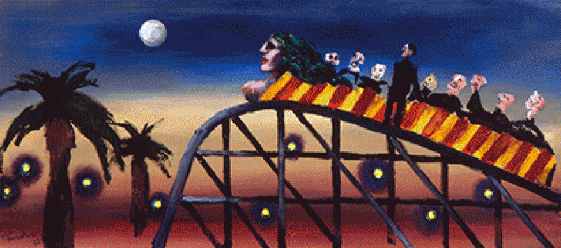 Part of the ongoing series of exhibitions based on The Albert and Barbara Tucker Gift to Heide Museum of Modern Art, A Life in Art traces aspects of Albert Tucker’s development as one of Australia’s most distinctive and important artists, featuring a selection of paintings from across his career.
Part of the ongoing series of exhibitions based on The Albert and Barbara Tucker Gift to Heide Museum of Modern Art, A Life in Art traces aspects of Albert Tucker’s development as one of Australia’s most distinctive and important artists, featuring a selection of paintings from across his career.
Beginning with his fierce social commentaries set within 1940s wartime Melbourne, the exhibition presents key paintings from Albert Tucker’s subsequent travels in England, Europe and America, where he further absorbed the transformative influences of modernism, together with his paintings exploring Australian landscape and myth.
Portraying human drama and dissonant allegory in his images, Tucker was also driven by formal experimentation, as seen in his painted and photographic self-portraits – piercing images of self-observation which also reflect his stylistic development. Several are displayed in this exhibition together with portraits Tucker painted of family and friends in the final decades of his life.
Albert Tucker is known as one of Australia’s foremost artists and as a key figure in the development of Australian modernism in Melbourne. Primarily a figurative painter, his works responded to the world around him and his own life experiences, and they often reflected critically on society.
During his career he played an active role in art politics, particularly in the 1940s, writing influential articles about the direction of art in Australia. He also held prominent positions within the art community, including President of the Contemporary Art Society in the late 1940s and again in the 1960s.
Tucker grew up during the Depression and began his career as a young artist in the late 1930s, in the years leading up to the outbreak of World War II. At this time, his world was defined by financial insecurity, social inequality and war, and these concerns became the catalyst for much of his painting.
Influenced by his peers as well as European modernism, he developed an expressive style through which he communicated his disillusionment about society during wartime. He believed the war contributed to a decay in moral values in Melbourne. His Images of Modern Evil series (1943–47) represented the city as a dangerous place and reflected a new spirit in Australian painting.
Imagery in his work from the 1940s also derived from his first hand experiences of the horrors of war. In 1942 he was based at the Heidelberg Military Hospital as an illustrator for medical records, and there saw soldiers suffering from horrific injuries and psychological damage. Often dark, ominous and unsettling, his wartime paintings interwove his pessimistic thoughts about war, life and society.
In the post-war years, Tucker travelled to Japan, Europe and America where he continued to paint. Together with Sidney Nolan and Russell Drysdale (who had already began to receive critical acclaim for their scenes of the Australian bush), he was instrumental in launching Australian painting to the international art scene.
In the mid-1950s, Tucker’s focus took a major shift away from the city to the Australian outback. Inspired by photographs of the Queensland drought that Nolan had shown Tucker in Italy in 1954, he began to paint Australia from afar. Tucker was interested in the harshness of the Australian landscape and depicted the outback as a seemingly inhabitable barren wasteland.
He developed a new motif at this time (c.1956) – the ‘Antipodean head’ – which became a symbol for an archetypal Australian character: “the bushranger, the man on the land and a Christ-like survivor”. Tucker returned to Melbourne in 1960 and he continued to paint until the end of his life.
He painted a range of subject matter, often revisiting past themes, but also focusing on portraiture. Tucker’s determination to succeed as an artist resulted in a career that made important contributions to the development of Australian modernism and the recognition of Australian art internationally.
A Life in Art: Albert Tucker
Heide Museum of Modern Art, 7 Templestowe Road, Bulleen
Exhibition continues to 19 March 2017
Admission fees apply
For more information, visit: www.heide.com.au for details.
Image: Albert Tucker, Extinction Express 1988, synthetic polymer paint on composition board, 61 x 137cm. Heide Museum of Modern Art, Melbourne. Gift of Barbara Tucker 2008
